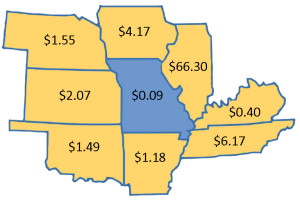 Transit Drives the Economy!
Transit Drives the Economy!
- A $10 million investment in public transportation results in a $30 million gain in sales for local businesses (3 times the public sector investment in transit capital).
- A study on U.S. government spending and its impact on worker productivity estimated that a 10-year $100 billion increase in public transportation spending would boost worker output by $521 billion, compared with $237 billion for the same spending on highways.
- According to the American Public Transit Association, for every dollar invested in Metro transit operations returns $4 to our local economy.
- Four in five Americans believe that increased investment in public transportation strengthens the economy, creates jobs, reduces traffic congestion and air pollution and saves energy.
- People use public transit in Missouri to get to jobs. Since the complete restoration of the service on November 29, 2010 in St. Louis since passage of Proposition A, 97 percent of all jobs in St. Louis City and St. Louis County can be reached by riding Metro transit according to Metro.
- Transit generates growth. To date, more than $16 billion in new development has occurred within a ten minute walk of MetroLink, with additional development in the works for many of the station areas.
- A study by the University of North Texas found that the new DART System in Dallas has already generated over $800 million in development and that the full system is projected to generate $3.7 billion in economic activity upon build out.
- St. Louis median income households with two commuters spend 19 percent of their household budgets on transportation, making it the second largest household expenditure after housing (26%).
- Transit creates jobs during initial design, construction and post construction where new developments arise along the line.
- Transit Oriented Development can play a key role in getting the Missouri economy back on track and creating jobs.
Transit is Good for the Environment.
- According to national transit experts, public transportation produces 95% less carbon monoxide, 90% less volatile organic compounds (vocs) and about half as much carbon dioxide and nitrogen oxide per mile compared to private vehicles.
- With more people using public transit, we decrease our reliance on fossil fuels. If one in 10 Americans used transit regularly, U.S. reliance on foreign oil could decline by more than 40%, or nearly the amount of oil imported from Saudi Arabia each year.
Transit is good for Public Health
- The U.S. Centers for Disease Control recommends that adults get at least 22 minutes of moderate physical activity per day to reduce the risk of heart disease, obesity, stroke and diabetes. By walking or biking to the bus stop or MetroLink, it’s easier to meet or exceed this goal.
- Transit reduces isolation particularly for seniors and people with disabilities, by providing access to grocery stores, medical services, jobs and schools.
- It supports safer streets which create healthier environments for residents according to the Pedestrian Network Analysis Report. In communities with good pedestrian infrastructure (things like wide sidewalks, safe crossings and bike connections), cars travel at slower speeds and there are fewer crashes.
Transit Moves People.
- An estimated 14 million Americans ride public transportation each weekday and an additional 25 million use it on a less frequent, but regular basis.
- In the last five years, transit use has increased faster than any other mode of transportation. It has increased 22% over the last six years.
- In St. Louis each day, more than 100,000 individuals board a Metrobus, train or van, amounting to 53 million riders a year.
- 10% of Metrobus and 7% of MetroLink riders are students traveling to school.
- Metro’s Call-A-Ride service provides more than 2,400 trips each day to people with disabilities and the elderly, exceeding 665,000 trips a year.
Where we Stand Today in Missouri.
St. Louis County voters approved a ½ cent sales tax on the April 6, 2010 ballot that now generates approximately $70 million annually for operations and expansion. This also triggered the collection of the ¼ cent sales tax approved in St. Louis City in 1997 for operations and expansion, which generates $8 million annually. However in order to leverage federal dollars for major expansion projects, the state will need to provide a minimum of $50 million a year in funding for public transit to Metro.

State of Missouri ranks 44th in public transportation funding among the 50 states. Of the state that rank below MO, 4 receive no state funding for transit including AL, AZ, HI and UT. Missouri spends only $0.09 per capita on public transportation funding. Last year the 32 Missouri transit providers received little more than $1 million total in funding to split among themselves. In 2011, Missouri’s per capita investment was $0.50, an 82 percent decline in 2 years.
The current level of state support for the public transit needs of citizens throughout the state is inadequate. In 2007 the Missouri Department of Transportation’s Missouri Long Range Transportation Plan identified the need for an additional $200 million annually to address Missouri’s unmet public transit funding needs. St. Louis is currently ranked one of the top 10 metro areas in the country where transportation takes the biggest bite out of household budgets.
Printable version: Transportation Talking Points
